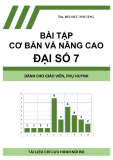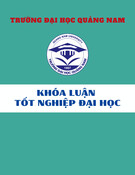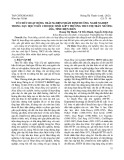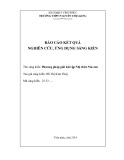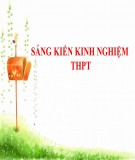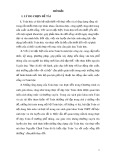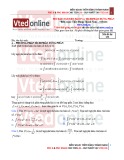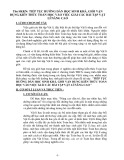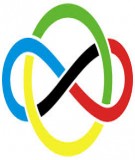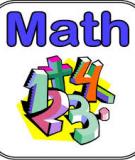EURASIP Journal on Wireless Communications and Networking
This Provisional PDF corresponds to the article as it appeared upon acceptance. Fully formatted PDF and full text (HTML) versions will be made available soon.
Decision making for cognitive radio equipment: analysis of the first 10 years of exploration
EURASIP Journal on Wireless Communications and Networking 2012,
2012:26
doi:10.1186/1687-1499-2012-26
Wassim Jouini (wassim.jouini@supelec.fr) Christophe Moy (christophe.moy@supelec.fr) Jacques Palicot (jacques.palicot@supelec.fr)
ISSN 1687-1499
Article type Review
Submission date
23 May 2011
Acceptance date
25 January 2012
Publication date
25 January 2012
Article URL http://jwcn.eurasipjournals.com/content/2012/1/26
This peer-reviewed article was published immediately upon acceptance. It can be downloaded, printed and distributed freely for any purposes (see copyright notice below).
For information about publishing your research in EURASIP WCN go to
http://jwcn.eurasipjournals.com/authors/instructions/
For information about other SpringerOpen publications go to
http://www.springeropen.com
© 2012 Jouini et al. ; licensee Springer. This is an open access article distributed under the terms of the Creative Commons Attribution License (http://creativecommons.org/licenses/by/2.0), which permits unrestricted use, distribution, and reproduction in any medium, provided the original work is properly cited.
1
Decision making for cognitive radio equipment: analysis of
the first 10 years of exploration
Wassim Jouini∗, Christophe Moy and Jacques Palicot
SUPELEC, SCEE/IETR, Avenue de la Boulaie, CS 47601, 35576 Cesson S´evign´e Cedex, France
∗Corresponding author: wassim.jouini@supelec.fr
Email addresses:
CM: christophe.moy@supelec.fr
JP: jacques.palicot@supelec.fr
Abstract
This article draws a general retrospective view on the first 10 years of cognitive radio (CR). More specifically,
we explore in this article decision making and learning for CR from an equipment perspective. Thus, this article
depicts the main decision making problems addressed by the community as general dynamic configuration adaptation
(DCA) problems and discuss the suggested solution proposed in the literature to tackle them. Within this framework
dynamic spectrum management is briefly introduced as a specific instantiation of DCA problems. We identified,
in our analysis study, three dimensions of constrains: the environment’s, the equipment’s and the user’s related
constrains. Moreover, we define and use the notion of a priori knowledge, to show that the tackled challenges by
the radio community during first 10 years of CR to solve decision making problems have often the same design
space, however they differ by the a priori knowledge they assume available. Consequently, we suggest in this
article, the “a priori knowledge” as a classification criteria to discriminate the main proposed techniques in the
literature to solve configuration adaptation decision making problems. We finally discuss the impact of sensing
errors on the decision making process as a prospective analysis.
Keywords: cognitive radio; decision making problems; dynamic configuration adaptation; design space; a priori
knowledge.
2
1. Introduction
The increase of computational capacity associated with (rather) cheap flexible hardware technologies (such
as programmable logic devices, digital signal processors and central processing units) offer a glimpse into
new ways to designing and managing future non military communication systems.a As a matter of fact in
1991, Joseph Mitola III argued that in a few years, at least in theory, software design of communication
systems should be possible. The term coined by Joseph Mitola to present such technologies is software
defined radio (SDR) [1]. For illustration purposes, today’s radio devices need a specific dedicated electronic
chain for each standard, switching from one standard to another when needed (known as the Velcro
approach [2]). With the growth of the number of these standards (GSM, EDGE, Wi-Fi, Bluetooth, LTE,
etc.) in one equipment, the design and development of these radio devices has become a real challenge
and the practical need for more flexibility became urgent. Recent hardware advances have offered the
possibility to design, at least partially, software solutions to problems which were requiring in the past
hardware signal processing devices: a step closer to SDR systems.
In specific, several possible definitions exist—and are still a matter of debate in the community—to
define SDR systems. For consistency reasons, we briefly describe software related radio concepts as agreed
on by the SDR Forum [3]. This matter is further discussed in [4]. The SDR Forum defines SDR as radio in
which some or all of the physical layer functions are software defined where physical layer and software
• Physical layer: The layer within the wireless protocol in which processing of radio frequency, inter-
defined terms are respectively described as:
mediate frequency, or baseband signals including channel coding occurs. It is the lowest layer of the
• Software defined: Software defined refers to the use of software processing within the radio system
ISO seven-layer model as adapted for wireless transmission and reception.
or device to implement operating (but not control) functions.
Thus, SDR systems are defined only from the design and the implementation perspectives. Consequently
3
it appears as a simple evolution from the usual hardwired radio systems. However, with the added software
layer, it is technically possible with current technology to control a large set of parameters in order to adapt
on the fly radio equipment to their communication environment (e.g., bandwidth, modulation, protocol,
power level adaptation to name a few). Nevertheless the control and optimization of reconfigurable radio
devices need the definition of optimization criteria related to the equipment hardware capabilities, the
users’ needs as well as the regulators’ rules. Introducing autonomous optimization capabilities in radio
terminals and networks is the basis of cognitive radio (CR), term also suggested and coined by Joseph
Mitola III [5, 6].
Mitola [6] defined CR, in his Ph.D dissertation as follows: The term CR identifies the point at which
wireless personal digital assistant (PDAs) and the related networks are sufficiently computationally intel-
ligent about radio resources and related computer to computer communication to:
(1) Detect user communication needs as a function of use context, and
(2) Provide radio resources and wireless services most appropriate to these needs.
Thus, the purpose of this new concept is to autonomously meet the user’s expectations, i.e., maximizing
his profit (in terms of QoS, throughput or power efficiency to name a few) without compromising the
efficiency of the network. Hence, the needed intelligence to operate efficiently must be distributed in both
the network and the radio device.
In this article, we suggest to provide a brief discussion on the decision making problems seen from
CR equipment’s perspective and discussed in the literature as well as the main solutions suggested to
tackle these problems. For that purpose, we revisit in Section 2 the rise of CR paradigm from which we
discuss a basic definition. Then, in order to objectively compare the techniques introduces to address CR
related decision making problem, we describe a conceptual object referred to as design space in Section
3. This conceptual object was introduced in the literature [7] to suggest that the CR design problem, from
the decision making perspective, is better defined by a set of constrains rather than by a set of degrees
of freedom. Thus, this section reminds us of the three considered dimensions of constrains viz., the
4
environment’s constraint, the equipment’s limits and the user’s needs. Moreover, in Section 4, we define
and use the notion of a priori knowledge, to show that the tackled challenges by the radio community to
solve configuration adaptation decision making problems have often the same design space, however they
differ by the a priori knowledge they assume available on this design space. Consequently, in Section 4,
we suggest the a priori knowledge as a classification criteria to discriminate the main proposed techniques
in the literature to solve configuration adaptation decision making problems. Section 5, extends previous
classification by adding the impact of observation accuracy and the benefit of learning techniques in such
contexts. Section 6 concludes this analysis.
2. Cognitive radio
2.1. The rise of CR
To fulfill the requirements to enable smart and autonomous equipment, Mitola and Maguire introduced the
notion of cognitive cycle as described in Fig. 1, [5,6], where the cognitive cycle presupposes the capacity
to collect information from the surrounding environment (perception), to digest it (i.e., learning, decision
making, and predicting tools) and to act in the best possible way by considering several constraints and
the available information. The reconfiguration of radio equipment is not discussed in depth, however, it
is generally accepted that SDR in an enabling to technology support CR [4].
As illustrated in Fig. 1, a full cognitive cycleb demands at every iteration five steps: observe, orient, plan,
decide, and act. The observe step deals with internal as well as external metrics. It aims at capturing the
characteristics of the environment of the communication device (e.g., channel state, interference level or
battery level to name a few.). This information is then processed by the three following steps: orient, plan,
and decide steps, where priorities are set, schedules are planed according to the systems constraints, and
decisions are made. Finally an appropriate action is taken during the act step (such as send a message,
reconfigure, modify power level to name a few). In order to complete the cognitive cycle, a last and
final step is needed to enhance the decision making engine of the communication device: the learn step.
5
As a matter of fact, learning abilities enable communication equipment to evaluate the quality of their
past actions. Thus, the decision making engine learns from its past successes and failures to tune its
parameters and adapt its decision rules to its specific environment. Learning can consequently help the
decision making engine to improve the quality of future decisions.
As far as we can track the emergence of a CR literature and to the best of authors’ knowledge, the today’s
plethoric publications started with three major contributions: On the one hand, the federal communication
commission (FCC) pointed out in 2002 the inefficiency of static frequency bands’ allocation to specific
wireless applications, and suggested CR as a possible paradigm to mitigate the resulting spectrum scarcity
[8,9]. Then, Haykin in article [10] in 2005, suggested a simplified cognitive cycle to represent CR
decision making engines as illustrated in Fig. 2. Haykin’s model tackled the particular dynamic spectrum
management problem and discussed different possible models to design future CR networks. Article [10]
inspired many studies on CR application fields such as theory based cognitive networks. Eventually, this
two subjects led to two very actives research fields as illustrated in this recent surveys [11–13]. On
the other hand, while the two contributions [8,10] focus on spectral efficiency, Rieser suggested, through
various publications, synthesized in his Ph.D. dissertation, [14] in 2004, a biologically inspired CR engine
that relies on genetic algorithms (GA). To the best of authors’ knowledge, it was the first suggested and
partially implemented CR engine presented to the community.
In this article although we cannot avoid mentioning CR applications from spectrum management
perspective, we focus on the decision making and learning mechanisms designed to deal with broader
frameworks, i.e., configuration adaptation problems. Thus, spectrum management problems are, from the
equipment point of view, but a subset of configuration adaptation problems.
2.2. Basic cognitive cycle
Since the original definition suggested by Joseph Mitola III, several other definitions were proposed to
define the edges of CR [4,8–10,15–17]. However, defining cognition is, in general, a harsh task. In the
6
• environment perception (or observation)
• and reasoning (or analysis/decision).
context of CR, basic cognitive abilities are considered:
Based on these cognitive abilities, a CR needs to take appropriate actions to adapt itself to its surrounding
environment.
Once again these notions know several possible definitions that we do not explicit in this article.
However, the basic cognitive cycle considers three macro-steps as illustrated in Fig. 3 and that we can
define as follows:
(1) Observation: Through its sensors the CR gathers information on its environment. Raw data and
preprocessed information helps the agent to build a knowledge base. In this context, the term
environment is used in a broad sense referring to any source of information that could improve the
CR’s behavior (internal state, interference level, regulators’ rules and enforcement policies, to name
a few).
(2) Analysis/decision: This macro-step, presented as a black box in this case, includes all needed
operations before given specific orders to the actuators (i.e., before reconfiguration in CR contexts).
Depending on the level of sophistication, this step can deal with metric analysis, performance
optimization, scheduling, and learning.
(3) Action: Mainly parameter reconfiguration and waveform transmission. A reconfiguration manage-
ment architecture needs to be implemented to ensure efficient and quick reconfigurations [18].
This definition is quite general. It can incorporate simple designs as well as complex ones. Most of
the published articles deal however with a restricted problem: spectrum management. In such context, the
• Geolocation [19–22].
• Spectrum occupation [23–27].
term environment finds more specific definitions such as the followings to name a few: Environment:
7
• Interference level (or interference temperature [10]).
• Noise level uncertainty [28–30].
• Regulatory rules (that define the open opportunities [11] for instance).
Thus, depending on the considered environment, specific sensors are to be designed [4,31,32]. The
captured -and/or computed- metrics by the sensors are then processed by the decision making engine.
The kind of process highly depends on the quality of the metrics (level of uncertainty on the captured
numerical value for instance) as well as the global information held by the CR. Finally, the made decisions
are translated into appropriate bandwidth occupation and power allocation actions.
3. Decision making problems for CR
Within the basic cognitive cycle, we focus in this section on the analysis step, and more specifically
on learning and decision making. We mainly find, in the literature two approaches. On the one hand,
some of the articles focus on implementing smart behavior into radio devices to enable more adequate
configurations, adapted to their environment, than those imposed by radio standards. As a matter of
fact, standard configurations are usually over dimensioned to meet the requirements of various critical
communication scenarios. This approach mainly focuses on one equipment, ignoring the rest of the
network. We refer to the problem related to the first approach as dynamic configuration adaptation (DCA)
problem. On the other hand due to a more pressing matter, most of CR related articles focus on spectrum
management. These latter articles aim at enabling a more efficient use of the frequency resources because
of its scarcity. This second problem is usually referred as dynamic spectrum access problem (DSA).
3.1. Design space and DCA problem
In this section, we discuss some of the limits related to the idealized CR concept before introducing the so
called DCA problem. Several questions arise when designing a CR engine. We summarize our conceptual
approach, presented in article [7], to dimension the decision making and learning abilities of a cognitive
8
engine. Thus, we introduce the notion of design space as a conceptual object that defines a set of CR
decision making problems by their constraints rather than by their degrees of freedom. We identified,
in our analysis study, three dimensions of constrains: the environment’s, the equipment’s, and the user’s
related constrains.
Ideally speaking, CR concept—supported by an SDR platform—opens the way to infinite possibilities.
Autonomous and aware of its surrounding environment as well as of it own behavior (and thus of its own
abilities), any part of the radio chain could be probed and tested to evaluate its impact on the device’s
performance. This however implies that the equipment is also able, in its reasoning process, to validate
its own choices. Namely, it must self-reference its cognition components [33]. Unfortunately, this class
of reasoning is well known in the theory of computing to be a potential black hole for computational
resources. Specifically, any turing-capable (TC) computational entity that reasons about itself can enter
a G¨odel-turingc loop from which it cannot recover [33].
To mitigate this paradox, time limited reasoning has been suggested by Mitola. As a matter of fact,
radio systems need to observe, decide, and act within a limited amount of time: The timer and related
computationally indivisible control construct is equivalent to the computer-theoretic construct of a step-
counting function over “finite minimalization.” It has been proved that computations that are limited with
reliable watchdog timers can avoid the G¨odel-turing paradox to the reliability of the timer. This proof is
a fundamental theorem for practical self-modifying systems [33].
Realistic CR frameworks need to take into account a large set of possible configurations, however, as
mentioned hereabove through the G¨odel-paradox, the decision making engine also needs to be constrained
in order to avoid the system to crash. We argue in the rest of this paragraph that, in general, CR decision
making problems are better defined by their constraints rather than by their degrees of freedom.
When designing such CR equipments the main challenge is to find an appropriate way to correctly
dimension its cognitive abilities according to its environment as well as to its purpose (i.e., providing a
9
certain service to the user). Several articles in the literature have already been concerned by this matter
however their description of the problem usually remained fuzzy (e.g., [6,14,34–36]). We summarize
their analysis by defining three “constraints” on which the design of a CR equipment depends: First, the
constraints imposed by the surrounding environment, then the constraints related to the user’s expectations
and finally, the constraints inherent to the equipment. We argue that these constraints help dimensioning
the CR decision making engine. Consequently, an a priori formulation of these elements helps the designer
• The environment constraints: since a CR is a wireless device that operates in a surrounding com-
to implement the right tools in order to obtain a flexible and adequate CR.
municating environment, it shall respect its rules: those imposed by regulation for instance (e.g.,
allocated frequency bands, tolerated interference, etc.) as well as its physical reality (propagation,
multi-path and fading to name a few) and network conditions (channel load or surrounding users’
activities for instance). Thus the behavior of CR equipments is highly coordinated by the constraints
imposed by the environment. As a matter of fact, if the environment allows no degree of freedom to
the equipments, this latter has no choice but to obey and thus looses all cognitive behavior. On the
other side, if no constraints are imposed by the environment, the CR will still be constrained by its
• User’s expectations: when using his wireless device for a particular application (voice communication,
own operational abilities and the expectations of the user.
data, streaming and so on), the user is expecting a certain quality of service. Depending on the awaited
quality of service, the CR can identify several criteria to optimize, such as, minimizing the bit error
rate, minimizing energy consumption, maximizing spectral efficiency, etc. If the user is too greedy
and imposes too many objectives, the designing problem to solve might become intractable because
of the constraints imposed by the surrounding environment and the platform of the CR. However if
the user is expecting nothing, then again there is no need for a flexible CR. Usually it is assumed
that the user is reasonable in a sense that he accepts the best he could get with a minimum cost as
long as the quality of service provided is above a certain level.d
10
• Equipment’s operational abilities: These limitations are perhaps the most obvious since one cannot
ask the CR equipment to adapt itself more than what it can perform (sense and/or act). It is usually
assumed in the CR literature that the equipment is an ideal software radio, and thus, that it has all the
needed flexibility for the designed framework. On a real application the efficiency of CR equipments
depends of course on the degrees of freedom (or equivalently the constraints) inherent to the wireless
platform used to communicate. As examples of commonly analyzed degrees of freedom one can find:
modulation, pulse shape, symbol rate, transmit power, equalization to name a few. In all cases, a CR
is designed to target and support given scenarios. We do not consider that CR can be designed to
answer all scenarios or concepts [18].
The interaction between all three constraints is further emphasized through the notion of design space.
We denote by CR design space an abstract three dimensional space that characterizes the CR decision
making engine as shown in Fig. 4. It is indeed abstract since it does not have any rigorous mathematical
meaning but it is only used to visually and conceptually illustrate the dependencies of the CR decision
making engine to the “design dimensions”: environment, parameters (usually referred to as knobs) and
objectives (or criteria defined from the user’s expectations).
In Fig. 4, we represent two sub-spaces referred to as actual design space and virtual design space.
On the one hand, the virtual design space refers to the upper bound support of the design space where
all three dimensions are considered independently from each others. Its volume can be interpreted as the
largest space of decision problems one could define from the three dimensions. On the other hand, the
actual design space is included in the virtual design space. It results from the reduction of the design space
when taking into account the correlation between the different constraints imposed by every dimension of
the design space. For instance, some constraints on the environment such as, “imposed fixed waveform”
might limit some objectives such as “find a waveform that maximizes the spectral efficiency”.
To define a specific decision making problem, one needs to introduce a last-possibly implicit- func-
11
tion. This latter represents a functional relationship between all three dimensions, more specifically the
correlation between the different constraints as illustrated by the design space. Thus, it models the
interdependence of all three constraints. A simple representation of this interdependence can be expressed
through an explicit objective function which numerical value is computed as a function of the equipment
parameters, the environment’s conditions as well as the values of other objective functions. Unfortunately
such functions are not always available and might remain implicit. In such scenarios, optimization might
prove problematic without using appropriate learning tools.
Finally, based on the here above presented analysis, all configuration adaptation problems seem to have
the same roots. However, to define a specific problem among the set of possibilities in the design space,
prior knowledge is important. This latter notion is further detailed in Section 4, where a classification
of decision making tools as a function of prior knowledge is suggested. Nevertheless, the general DCA
problem can be described as the most general decision making design space that we can state as follows
[7]:
Within this framework, we assume that the environment constrains the CR by allowing only K possible
configurations to use. This condition characterizes the environment and the equipment. Moreover we
assume that there exist M ≥ 1 objectives that evaluate how well the equipment performs to meet the
users expectations.
To conclude, we usually observe in the literature that these constrained based characterizations are
implicitly made. Thus, usually the assumptions introduced to define the decision making framework are,
unfortunately, hardly explained. These assumptions concern what we refer to as the “a priori model
knowledge”. In Section 4, we introduce and explain the notion of a priori knowledge and we present a
brief state of the art on decision making for CR configuration adaptation using the DCA design space. We
show that although the design space is the same, depending on the a priori model knowledge, different
approaches are suggested by the community to tackle the defined decision making problems.
12
The following section describes an important case of DCA know as DSA that we briefly describe for
the sake of consistency.
3.2. Spectrum scarcity and dynamic spectrum access
Since the early 90s, the radio community captured the potential industrial and economic opportunities
that could emerge from a better frequency resource usage as noticed in 2004 in article [37]: A trend
that has the potential to change the current industrial structure is the emergence of alternative spectrum
management regimes, such as the introduction of so called “unlicensed bands”, where new technologies
can be introduced if they fulfil some very simple and relaxed “spectrum etiquette” rules to avoid excessive
interference on existing systems. The most notable initiative in this area is the one of the federal com-
munications commission (FCC, the regulator in USA) in the early 90s driving the development of short
range wireless communication systems and wireless local area networks (WLANs).
Exploiting portions of the spectrum to unlicensed usage was a first step to introducing alternative
frequency management schemes. Rethinking the main regulatory frameworks imposed for decades is
the next step. As a matter of fact, during the last century, most of the meaningful spectrum resources
were licensed to emerging wireless applications, where the static frequency allocation policy combined
with a growing number of spectrum demanding services led to a spectrum scarcity. However, several
measurements conducted in the United-States first, and then in numerous other countries [8, 23–27],
showed a chronic underutilization of the frequency band resources, revealing substantial communication
opportunities.
With the advent of SDR technology, it became, at least theoretically, possible to design agile systems
capable of switching from one frequency band to another depending on given communication constraints.
Thus, during the years 2002 and 2003 several task forces and researches suggested new frequency
management policies and regulatory frameworks to enable efficient use of the spectrum resource [8,
38–43]. The consequences of this new framework are that the spectrum management model of today
13
is abolished for large parts of the spectrum. Instead, “free”e spectrum trading becomes the preferred
mechanism and technical systems that allow for the dynamic use and re-use of spectrum becomes a
necessity [37].
The DSA encompasses all suggested approaches that emerged from the early definitions of efficient
and “free” spectrum access or trading. In 2007, article [44] suggested one possible and simple taxomonyf
to classify the different suggested spectrum management approaches as illustrated in Fig. 5. Three main
approaches can be discriminated: dynamic exclusive use model, open sharing model (spectrum commons
• Dynamic exclusive use model: the spectrum basically is allocated exclusively to specific services
model), and hierarchical access model:
or operators. However, the spectrum property rights framework allows opening a secondary market
where the licensed users can sell and trade portion of their spectrum, whereas the dynamic spectrum
allocation framework aims at providing a better allocation of the spectrum, to exclusive services, by
• Open sharing model (spectrum commons model): aims at generalizing the success encountered by
adapting the spectrum allocation to space and time network load information.
WLAN technologies within the ISM band. In other words, it mainly suggests opening portions if the
• Hierarchical access model: this framework introduced a secondary network that aims at exploiting
spectrum to unlicensed users.
resources left vacant by the incumbent users [usually referred to as primary users (PU)]. Secondary
users (SUs) are able to communicate as long as they do not cause harmful interference to PUs. In
this article, we do not subdivide this framework. As a matter of fact, their are as many subsets as
the possible communication opportunities to exploit: power control, ultra-wide band communication
under PUs noise level, spectrum hole detection and exploitation, directional communications to name
a few [11]. In general, it is refers to as opportunistic spectrum access (OSA).
Since the seminal article of Haykin [10] in 2005, OSA research community has been, to the best of
authors’ knowledge the most active in the field of DSA. With several network models based on game
14
theory [13], Markov chains or multi-armed Bandit (MAB) (and machine learning in general) [44–50], to
name a few, and relying on the concept of CR, the community tackled several challenges encountered
when dealing with OSA such as (non exhaustive): dynamic power allocation, optimal band selection
(with or without prior knowledge on the occupancy pattern of the spectrum bands by PUs), as well as
cooperation among the different SUs [12] centralized or decentralized, with or without observation errors.
In Section 5.2 an OSA scenario based on a MAB model, described in article [48], is summarized and
illustrates the impact of observation errors on decision making for CR. In the following section, however,
we introduce prior knowledge as a classification criteria among the main learning and decision making
tools suggested in CR articles.
4. Decision making tools for DCA
The a priori knowledge is a set of assumptions made by the designer on the amount and representation
of the available information to the decision making engine when it first deals with the environment. As
a matter of fact, “knowledge” is defined by the Oxford english dictionary as: (i) expertise, and skills
acquired by a person through experience or education; the theoretical or practical understanding of a
subject, (ii) what is known in a particular field or in total; facts and information or (iii) awareness or
familiarity gained by experience of a fact or situation. Consequently, within the CR framework, we can
define the a priori knowledge as the set of theoretical or practical assumptions provided by the designer
to the CR decision making engine. These assumptions, if they are accurate, provide the CR with valuable
information on the problem to deal with. These remarks lead us to suggest that the decision making
problems the CR has to deal with are defined by the set {design space, a priori knowledge}. In other
words, depending on the a priori knowledge on the environment, some decision making approaches offer
a better fit to the decision making framework than others. Moreover, we assert that a few, if not many,
different cognitive engines could cohabit in a single CR equipment and will have to coordinate their
actions [51]. Thus, recently (2011), a CR decision making engine based on prior knowledge has been
15
suggested in [52]. In the following sections we briefly describe the different approaches provided by the
community depending on the a priori knowledge assumed relevant to tackle the environment the CR
might face during its life time. In Fig. 6 we suggest to classify these techniques depending on the a priori
knowledge provided to the cognitive decision making engine.
4.1. Expert approach
The expert approach relies on the important amount of knowledge collected by telecommunication en-
gineers and researchers. This knowledge is based on theoretical consideration and practical measures
on the environment and radio communication parameters. It was first suggested by Mitola in his Ph.D.
dissertation on CR [6]. Through intensive off-line simulations, expert systems are provided with a set
of inference rules. These rules are then used on-line to adapt the equipment depending on the context
faced by CR equipments. Thus, the more available knowledge, the better the equipment can adapt itself
to its surrounding dynamic environment. However, this knowledge is usefully as long as if the CR can
represent its knowledge in a way that enables to exploit it and to react to the environment by adequate
adaptations of its operating configuration. For that purpose, Mitola suggested representing the knowledge
of CR equipments using a new dedicated language radio communication: “radio knowledge representation
language” (RKRL) [6,33]. This representation of knowledge uses web semantic such as XML (eXtensible
Markup Language), RDF (resource description framework), and OWL (web ontology language). The
expert knowledge based approach had a large success especially due to the XG project (neXt Generation)
supported by the DARPA (e.g., [53] and for spectrum sharing: [54]). As a matter of fact, if the knowledge
is well represented and provided to the equipment as a set of rules, the decision making process becomes
• The behavior of the designed system is not tuned to a particular user but to all users and to a set of
very simple. However this approach has a few drawbacks:
probable environments. Moreover in order to acquaint the CR decision making engine with valuable
and large knowledge, an important amount of effort is needed from the designer.
16
• Expert knowledge is mainly based on models. Thus the system might behave in a poor way when it
is facing unexpected dynamics in the environment.
The techniques based on expert systems can, however be supported by several other tools (some are
discussed later) to help them acquire new knowledge on the environment or help them avoid conflicts
between different configuration adaptation rules. A similar approach, based on an ontology to model the
knowledge of the decision making engine was recently suggested [55–58]. Where a common language to
radio devices is suggested based on an ontology, expressed in OWL and implemented on the USRP card
[59] using GNU radio [60].
4.2. Exploration based decision making
In some contexts, one can consider that there is a priori knowledge available on the complex relationships
existing between, the metrics observed, the parameters to adapt and the criteria to satisfy as described in
Fig. 7. In this case the problem appears to be a multi-criteria optimization problem. Within this framework,
the CR decision making engine aims at finding the best parameters to meet the users expectations by
solving a set of equations as shown in Table Two of article [61] from which is extracted Fig. 7). This
• there exists no universal definition of optimality in this case. Thus the solution of this problem are
problem is known to be complex for several reasons:
satisfactory (or not) with respect to a certain function, usually named fitness that evaluates how well
• Thus usually a large space of possible “good” configurations can be available.
• The criteria are correlated and can be in conflict (e.g., Fig. 7).
the criteria were satisfied.
If we assume that the previously mentioned off-line expert rule extraction phase has not been (or
partially) accomplished an exploration of the space of possible configurations is needed.
There exists various possible algorithm to explore a large set of potential candidates. The most obvious
one is probably “exhaustive search”, where all possible candidates are computed and evaluated in order to
17
find the best solution. However, when the number of candidates grows large, such approaches can become
computationally burdensome and miss the imposed decision making deadlines. Usually in such contexts,
heuristics are preferred. In the context of CR, finding the best solution might not be necessary. Instead,
the cognitive engine would rather find, within the imposed limited amount of time, a satisfactory solution.
• Available a priori knowledge on the complex relationships existing between, the metrics observed,
Consequently, if the following criteria are met:
• Possible heavy parallel computing.
the parameters to adapt and the criteria to satisfy.
Then a large set of decision making tools are possible such as: simulated annealing, GAs, and swarm
algorithms to name a few [62]. Notice that such approaches did not wait for CR to be used on radio
technologies. In 1993, article [63] already suggested simulated annealing as a possible solution to deal
with channel assignment for cellular networks.g
Genetic algorithms [14,34,61], Swarm Algorithms [64, 65] and insect colony inspired algorithms [66]h
techniques are usually referred to as bio-inspired or evolutionary techniques.
This defined CR decision making framework was first analyzed by Rieser and Rondeau. They suggested
the use of GAs to tackle this framework [14,34,61]. GAs were first designed to mimic Darwin’s evolution-
ary theory and are well known for their capacity to adapt themselves to a changing environment. Without
using our formalism, their study showed that under what we define as design space and with the described
a priori knowledge, the GAs provide cognitive radios with an efficient and flexible decision making engine.
But we cannot consider their model as a generality for all CR use cases, so that other solutions have to be
considered additionally. Further details on the different versions suggested and implemented by Virginia
Tech can be found in the following recent survey [67].i
Notice, that once again, prior knowledge can substantially enhance the behavior of these algorithms.
An interesting illustration can be found in article [52] in the case of GAs based decision making engines.
18
4.3. Learning approaches: exploration and exploitation
As we argued in the previous sections and as several other authors [36,68] noticed, “Many CR proposals,
such as [61,69,70], rely on a priori characterization of these performance metrics which are often derived
from analytical models. Unfortunately, [. . . ], this approach is not always practical due to e.g., limiting
modeling assumption, non-ideal behaviors in real-life scenarios, and poor scalability” [68]. To avoid these
limitations and in order to tackle more realistic scenarios, many methods based on learning techniques were
suggested: artificial neuronal networks (ANN), evolving connectionist systems (ECS) [71,72], statistical
learning [73], regression models and so on. All of these approaches have their cons and pros, however
they all have in common that they mainly rely on trials conducted within a real environment to try and
infer from it decision making rules for CR equipments. Since this learning tools aim at representing the
functional relationship between the environment (through the sensed metrics), the systems parameters and
the criteria to satisfy, they need a direct interaction with the environment in order to build a posteriori
knowledge on their environment. In this study we sub-classify these methods depending on the way they
learn and exploit their rules. On the one hand (i), we find a set of techniques that separates exploration
and exploitation phases. On the other hand (ii), we find other techniques more flexible that combine both
processes.
In the first mentioned case (i) we find several tools such as ANN or statistical learning already used
and exploited in other domain requiring some cognitive abilities (robotics, video games, etc.). These
methods have two phases: a phase of pure “exploration” where the CR decision making engine learns
and infers to find (explicitly or implicitly) decision making rules, then uses in a second phase this a
posteriori knowledge to make decision. Since these learning techniques rely on a first learning phase,
a large amount of data and computational power is needed in order to extract reliable knowledge. This
difficulty is already known concerning ANN for instance. It is still true for statistical learning. As noticed
by Weingart in article [73], the provided techniques are still computationally prohibitive, and not ready
yet to be used in a real equipment. However if the first phase is well achieved the second phase is usually
19
very simple and does not require much time or energy [68]. In the second case (ii), we find promising
techniques recently introduced to the community and still need to be further investigated [17,36] in the
case of configuration adaptation.j These techniques try to provide the CR with a flexible and incremental
learning decision making engine. In the case of ECS based decision making engine, Colson suggested the
use of an evolving neural network [71, 72]. Unlike the usual ANN, the ECS-NN can change its structure
without “forgetting” already learned knowledge. Thus new rules can be learned by adding new neurons
to the neural structure. In order to be efficient the architecture proposed in [36] needs some expert advice
(a priori knowledge) on the several available configurations. These added information ranks the different
configurations based on some criteria (robustness, spectral efficiency, etc.) but without knowing a priori
which one is more adequate when facing a certain environment.
More recently, article [17] however assumes that no a priori knowledge is provided and that the
performance of the equipment can only be estimated when trying a specific configuration. The associated
tools are based on the so-called MAB framework. One advantage here is to provide learning solutions while
operating, even if the cognitive engine is facing a completely new environment. Of course, performance
increase while the learning process progresses. Note that this approach is also proving its accuracy in the
OSA context [47].
To conclude this section, we would like to emphasize the fact that the proposed classification in this
article shows that a CR equipment cannot depend on only one core decision making tool but on a pool of
techniques. Every time it faces an environment, the equipment needs to have an estimation of its a priori
knowledge and on its reliability. To tackle a particular context, the general process can be summarized
through three questions: What can’t I do (design space)? What do I already know (a priori knowledge)?
And what technique should I select to solve the decision making problem?
In the following section we extend the analysis to the specific and practical context of imperfect sensing.
As a matter of fact the impact of sensing errors can be significant on decision making techniques. However,
unfortunately, very few studies seem to tackle this specific problem within CR contexts. Hence, we further
20
discuss this matter hereafter.
5. Decision making in the context of sensing errors
As illustrated through the notion of basic cognitive cycle, decision making, and learning rely on prior
observations of the environment. Consequently, the performance of the implemented decision making tools
highly depends on the quality of the observations. Unfortunately, we could not find substantial quantitative
material evaluating the impact of sensing errors on decision making and learning tools. Thus, we suggest
to qualitativelyk discuss, in this section, the impact of sensing errors on the previously discussed decision
making tools for CR. For that purpose we rely on a specific problem borrowed from the OSAl community
to illustrate this discussion where the problem of decision making in the context of sensing errors is
clearly formalized and the impact of such errors on the considered learning algorithm’s performance is
quantified.
5.1. An example of learning approach
Opportunistic spectrum access is a particularly interesting framework that illustrates the challenge faced
when learning under uncertainty. When tackling the general DCA problem, described hereabove, while
considering K channels to probe, the problem that consists in maximizing the cumulated throughput of
the user over the number of transmission trials appears to be consistent with a MAB paradigm [74,75].
In a nutshell, based on the analogy with the one-armed bandit (also known as slot machine), it models
a gambler sequentially pulling one of the several levers (MAB) on the gambling machine. Every time a
leverm is pulled, it provides the gambler with a random income usually referred to as reward. Although
we assume that the gambler has no a priori information on the rewards’ stochastic distributions, he aims
at maximizing his cumulated income through iterative pulls. In the OSA framework, the SU is modeled
as the gambler while the frequency bands represent the levers. The gambler faces at each trial a trade-off
between pulling the lever with the highest estimated payoff (known as exploitation phase) and pulling
21
another lever to acquire information about its expected payoff (known as exploration phase). We usually
refer to this trade-off as the exploration-exploitation dilemma. If the problem is assumed modeled as a
MAB framework an interesting way to tackle the problem is to use the class of so-called upper confidence
bound algorithmsn (UCB) [17,47,48,50,76]. The main advantage of UCB methods for CR is to offer a
balance between exploration and exploitation phases without interrupting the communication process, i.e.,
while providing a certain service to the user [17]. Namely, a CR based on UCB can jointly communicate
and learn. Thus it avoids the instantiation of two steps : a learning step during which the user has to wait.
And a communication step that depends on how well the first step performed. It is worth noticing that
the suggested illustration, in the article, is based on the so-called U CB1. This latter has been selected for
its rather low computational complexity compared to other techniques in the literature.
For illustration purpose, we use the following decision model for OSA of a SU having the choice
between ten frequency bands, each one used by PUs with a different probability, usually unknown to the
CR decision making engine. A complete model is provided in [48]. Only one band can be sensed and tried
at each iteration in order to keep the system’s complexity reasonable. Consequently, the cognitive engine
only has a partial information on the environment at each iteration and should derive the probability of
availability of the bands based on its previous trials. It provides a confidence bound on every band and
selects, for the next iteration, the band most likely to be free. Communication can be performed if the
band is detected as free; otherwise the SU backs off. However, the SU can make errors due to the non
perfect accuracy of its sensing detector. More specifically, the detector might detect the presence of a PU
while the band is in fact free and vice-versa. The consequence is that the SU does not transmit during
this iteration whereas he could, or transmits when he should not causing interference to the incumbent
users. We usually speak of false alarm in the former case and miss-detection in the latter case.
We see in Fig. 8 the impact of false alarms on the proportion of time a cognitive engine, relying on
the U CB1 [77,78] algorithm, choses the most available channel (considered as optimal in this case). This
proportion increases as the number of trials grow large, thus as the SU learns more on the availability of
22
the bands. We can see that with a probability of false alarm equal to zero, the decision making engine
needs 1,000 trials to obtain a selection rate of 72% of the most available channel. This ratio falls to 50%
after 1,000 trials for a probability of false alarm of 0.4, which is quite decent considering the scenario and
the heavy deterioration of sensing accuracy. In fact, in this case, a little bit more than twice the number
of iterations has been necessary compared to a perfect sensing scenario. But after 10,000 trials, the ratio
grows to achieve 96 and 92%, respectively. Consequently, the cognitive engine is able to communicate
and to converge towards the most available band in spite of the sensing errors it is suffering.
5.2. The impact of observation error and uncertainty on decision making
Analyzing the impact of uncertainty and sensing errors on the performance of a CR decision making
engine is very difficult. However due to the importance of this problem to the community, we suggest as
a closing point of this article, an intuitive and brief insight view on this matter. Within this framework
we consider that the sensing information we capture from the environment may contain errors. Then we
describe the potential consequence of such errors on the performance of class of algorithms previously
classified.
Due to their lack of flexibility, expert decision making techniques seem to be the most vulnerable to
uncertainty. As a matter of fact, their decision making process, based on either rules or predefined policies,
leads the CR to consider all observations as being correct. Hence a sensing errors provokes a behavioral
error. GA based decision making engines rely on explicit relationships between parameters, observations
and criteria. Consequently, sensing errors can highly impact the selection process as it introduces biases
in the performance evaluation of the different candidates. Moreover, generation after generation, these
errors would probably propagate leading to an inefficient selection process. Such decision making engines
would probably need to interact with environment to test the candidates and confirm their performance.
In such scenarios, the CA might be able to mitigate the impact of sensing errors at the cost however
of a burdensome process. ANN are usually depicted, when they fulfill given requirements, as universal
23
approximators. In other words, if the neural network is correctly designed to fit the decision making
problem, it can efficiently learn the implicit relationship that exists between parameters, observations and
criteria. Consequently even when sensing errors are present, the learning process can lead to capture
average patterns and thus appropriately mitigate their impact. Thus, the more learning abilities and
flexibility a decision making shows the more robust it become to uncertainty and sensing errors. This
analysis is further depicted in Fig. 6. Thus, we can summarize this intuitive insight view as follows: the
more the decision making technique is at the right of Fig. 6, the more robust to observation flaws it seems to
be. Notice that the learning process enable the CA to acquire knowledge on its environment. Consequently
a learning process fully achieved should lead to an expert decision. Figure 9 illustrates moreover a vertical
axis that suggests, when possible, that collaboration helps CR users to acquire through diversity a better
information on their environment. And thus, it enables them to improve the performance of their decision
making engine considering a given uncertainty level.
Taking into account the uncertainty on the environment sensing, we may assert that learning-oriented
techniques are more efficient. This is emphasized by the proposed classification based on the a priori
knowledge criteria on the environment. Hence, we believe that such approaches should be particularly
addressed by the CR community in the second decade of CR decision making era.
We tackled in this article decision making in the sense of a mono-equipment problem. In a multi-
equipment context, a higher level of decision (rule, policy, etc.) should specify how equipments cooperate
or not. This is out of the scope of this article. However, at the level of each equipment, decision goes
back to what has been stated in this article.
6. Conclusions
In this article, we presented a brief yet original retrospective view on the first 10 years of CR. More
specifically of the different challenges faced by the CR decision making community and the suggested
solution to answer them. We state that most of these decision making models have the same design space
24
however they differ by the a priori knowledge they assume available. Consequently, we suggested the “a
priori knowledge” as a classification criteria to discriminate the main proposed techniques in the literature
to solve configuration adaptation decision making problems. Moreover as a qualitative and prospective
analysis, we depicted through an toy example the impact of observation errors and uncertainty on CR
decision making engine.
We believe that this analysis made on the first 10 years of exploration of decision making for CR may
help gaining perspective on the topic and thus help addressing this research domain for the next coming
10 years.
aBoth US and European military have been working on such flexible and inter-operable defense systems
Endnotes
since the late 1970s. bIt is called full CR to oppose it to other simplified versions suggested in the literature
[4]. cA specific example of such paradox can be illustrated by the following sentence: ‘This sentence is
false!’ [79] as suggested by Mitola during a recent seminar at Sup´elec,
http://www.rennes.supelec.fr/ren/rd/scee/seminaire.html. dNotice that this assumption introduces the notion
of satisfactory behavior. We oppose it to rational thinking where the decision making engine always aims
at the most rewarding option. Thus when the decision making engine needs to learn in an uncertain
environment, satisfaction based reasoning can be introduced to accelerate the convergence rate of learning
algorithms for instance. e[...] “Trade, lease, and rent of licenses were possible without incurring excessive
administrative procedures and overhead costs” [37]. fA different, more detailed and more exhaustive, DSA
taxomony can be found in article [80]. gIt is indeed a very restrictive case of DCA and DSA where a
centralized entity, seen as the cognitive agent (CA) assigns frequency channels to its users depending on
the channel conditions. hTo the best of authors’ knowledge Swarm algorithms have only been exploited
in case of resource allocation. No complex configuration adaptation decision making engine was found in
the literature based on such techniques. iThis document is presented as a survey of the various suggested
25
decision making architectures for CR. We notice however, that except the one designed by Mitola, during
the DARPA xG Program, and those designed and implemented by Virginia Tech, the community around
this topic seems thin and advances slowly toward efficient architectures. Other suggested architectures
relying mostly on bio-inspired techniques tackle spectrum resource allocation related problems. jThese
same techniques, based on a MAB model, prove to be efficient to tackle some DSA related problems
as already discussed in Section 3.2. kTo the best of authors’ knowledge such studies have only been
conducted when dealing with OSA problems. Consequently, the presented results are exploratory and
need further investigations to fully confirm them. We find however the overall discussion interesting to
capture CR related decision making challenges. lAs mentioned earlier, we consider in this article that
OSA problems are but specific instantiations of DCA problems. mFrom a DCA problems perspective,
nUCB algorithms are given here as an example of learning-oriented approach. But the philosophy and
a lever is a specific configuration to be tested. Thus in OSA, it refers to a band to probe for instance.
conclusions of this section would match other learning techniques.
Competing interest
The authors declare that they have no competing interests.
[1] J Mitola III, The software radio architecture. IEEE Commun. Mag. 33, 26–38 (1995)
[2] ST Gul, Optimization of multi-standards software defined radio equipments: a common operators approach. Ph.D. Thesis, University
of Rennes 1, Rennes, France, 2009
[3] SDR Forum. Sdrf cognitive radio definitions, http://data.memberclicks.com/site/sdf/SDRF-06-R-0011-V1 0 0.pdf. Accessed Nov 2007
[4] J Palicot, Radio Engineering: From Software Radio to Cognitive Radio (Wiley, UK, 2011)
[5] J Mitola, GQ Maguire, Cognitive radio: making software radios more personal. Pers. Commun. IEEE 6, 13–18 (1999)
[6] J Mitola, Cognitive radio: An integrated agent architecture for software defined radio. PhD Thesis, Royal Inst. of Technology (KTH),
2000
References
26
[7] W Jouini, C Moy, J Palicot, On decision making for dynamic configuration adaptation problem in cognitive radio equipments: a
multi-armed bandit based approach, in 6th Karlsruhe Workshop on Software Radios, WSR’10, pp. 21-30, Karlsruhe, Germany, March
2010.
[8] Federal Communications Commission, Spectrum policy task force report, http://www.fcc.gov/sptf/files/SEWGFinalReport 1.pdf.
Accessed Nov 2002
[9] Facilitating opportunities for flexible, efficient ad reliable spectrum use employing cognitive radio technologies, in Federal Communi-
cations Commission Spectrum Policy Task Force, FCC, Washington, DC, March 2005, pp. 03–108
[10] S Haykin, Cognitive radio: brain-empowered wireless communications. IEEE J. Sel. Areas Commun. 23(2), 201–220 (2005)
[11] T Yucek, H Arslan, A survey of spectrum sensing algorithms for cognitive radio applications. IEEE Commun. Surv. Tutor. 11(1),
116–130 (2009)
[12]
IF Akyildiz, BF Lo, R Balakrishnan, Cooperative spectrum sensing in cognitive radio networks: a survey. Phys. Commun. 4(1), 40–62
(2011)
[13] B Wang, Y Wu, KJR Liu, Game theory for cognitive radio networks: an overview. Comput. Netw. 54, 2537–2561 (2010)
[14] CJ Rieser, Biologically Inspired Cognitive Radio Engine Model Utilizing Distributed Genetic Algorithms for Secure and Robust Wireless
Communications and Networking, PhD thesis, Virginia Tech, 2004
[15] FK Jondral, Software-defined radio - basics and evolution to cognitive radio. EURASIP J. Wirel. Commun. Netw. 2005(3), 9 (2005)
[16]
International Telecommunication Union, Definitions of software defined radio (sdr) and cognitive radio system (crs). Report ITU-R
SM.2152, SM Series, Spectrum management, Sept 2009
[17] W Jouini, D Ernst, C Moy, J Palicot, Multi-armed bandit based policies for cognitive radio’s decision making issues, in Proceedings
of the 3rd international conference on Signals, Circuits and Systems (SCS), Djerba, Tunisia, November 2009, pp. 1-6
[18] C Moy, High-level design approach for the specification of cognitive radio equipments management APIs. Journal of Network and
System Management. Spec. Issue Manage Funct. Cogn. Wirel. Netw. Syst. 18(1), 64–96 (2010)
[19] M Gibson, Tv white space geolocation database, in Workshop, IEEE 802 Plenary meeting, San Diego, 16 July 2010
[20] HR Karimi and Ofcom, Geolocation databases for white space devices in the uhf tv bands: Specification of maximum permitted
emission levels, in IEEE International Symposium on Dynamic Spectrum Access Networks (DySPAN), Aachen, Germany, 2011, pp.
231–241
[21] Motorola, Tv white space position paper. Fixed tv white space solutions
for wireless
isp network operators.
[On-
line]: http://www.techrepublic.com/whitepapers/tv-white-space-position-paper-fixed-tv-white-space-solutions-for-wireless-isp-network-
operators/1115419
[22] Office of Communication (Ofcom), Implementing geolocation,
http://stakeholders.ofcom.org.uk/binaries/consultations/geolocation/statement/statement.pdf.
Accessed Sept 2011
[23] MA McHenry et al., Spectrum occupancy measurements, Technical report, Shared Spectrum Company, Jan 2004–Aug 2005. Available
27
at http://www.sharedspectrum.com http://www.sharedspectrum.com.
[24] RIC Chiang, GB Rowe, KW Sowerby, A quantitative analysis of spectral occupancy measurements for cognitive radio, in Proceedings
of the IEEE 65th Vehicular Technology Conference (VTC 2007 Spring), Singapore, April 2007, pp. 3016–3020
[25] M Wellens, J Wu, P M¨ah¨onen, Evaluation of spectrum occupancy in indoor and outdoor scenario in the context of cognitive radio, in
Proceedings of the Second International Conference on Cognitive Radio Oriented Wireless Networks and Communications (CrowCom
2007), Netherlands, 2007, pp. 1–8
[26] MH Islam et al, Spectrum survey in Singapore: Occupancy measurements and analyses, in Proceedings of the 3rd International
Conference on Cognitive Radio Oriented Wireless Networks and Communications (CrownCom 2008), Singapore, May 2008, pp. 1–7
[27] M L´opez-Ben´ıtez, F Casadevall, A Umbert, J P´erez-Romero, J Palicot, C Moy, R Hachemani, Spectral occupation measurements and
blind standard recognition sensor for cognitive radio networks, in Proceedings of the 4th International Conference on Cognitive Radio
Oriented Wireless Networks and Communications (CrownCom 2009), Hannover, 2009, pp. 1–9
[28] A Sonnenschein, PM Fishman, Radiometric detection of spread-spectrum signals in noise of uncertain power. IEEE Trans. Aerosp.
Electron. Syst. 28, 654–660 (1992)
[29] R Tandra, A Sahai, SNR walls for signal detection. IEEE J. Sel. Top. Signal Process. 2(1), 4–17 (2008)
[30] W Jouini, Energy detection limits under log-normal approximated noise uncertainty. IEEE Signal Process. Lett. 18(7), 423–426 (2011)
[31] R Hachemani, J Palicot, C Moy. The “sensorial radio bubble” for cognitive radio terminals, in Proceeding in URSI, The XXIX General
Assembly of the International Union of Radio Science, Chicago, USA, Aug 2008, pp. 351–368
[32] J Palicot, C Moy, R Hachemani, Multilayer sensors for the sensorial radio bubble. Phys. Commun. 2, 151–165 (2009)
[33] J Mitola, Cognitive Radio Architecture - The Engineering Foundations of Radio Xml (Wiley-Blackwell, New York, 2006)
[34] TW Rondeau, Application of Artiffcial Intelligence to Wireless Communications. PhD thesis, Virginia Tech, 2006
[35] QinetiQ and Ofcom, Cognitive radio technology a study for ofcom, 1, http://stakeholders.ofcom.org.uk/market-data-research/technology-
research/research/emerging-tech/cograd/. Accessed Feb 2007
[36] N Colson, A Kountouris, A Wautier, L Husson, Cognitive decision making process supervising the radio dynamic reconfiguration, in
Proceedings of Cognitive Radio Oriented Wireless Networks and Communications, Singapore, 15–17 May 2008, pp. 1–7
[37] F Berggren, O Queseth, J Zander, B Asp, C J¨onsson, P Stenumgaard, NZ Kviselius, B Thorngren, U Landmark, J Wessel, Dynamic
spectrum access, http://www.wireless.kth.se/projects/DSA/DSA report phase1.pdf. Accessed Sept 2004
[38] FCC. Spectrum policy task force, report of the spectrum efficiency working group, November 2002
[39] DP Reed, How wireless networks scale: the illusion of spectrum scarcity, http://www.its.bldrdoc.gov/meetings/art/art02/slides02/speakers02.html.
Accessed Mar 2002
[40] P Kolodzy, Spectrum policy, technology leading to new directions?. National Spectrum Managers Association, May 2002
[41] DP Reed, Bits aren’t bites: Constructing a “communications ether” that can grow and adapt, March 2003
[42] FCC. Promoting efficient use of spectrum through elimination of barriers to the development of secondary markets. Report WT Docket
No. 00-230, Oct 2003
28
[43] P Kolodzy, Spectrum policy task force, findings and recommendations, in International Symposium on Advanced Radio Technologies
(ISART 2003), Boulder, Colo, USA, March 2003, pp. 168–239
[44] Q Zhao, BM Sadler, A survey of dynamic spectrum access: signal processing, networking, and regulatory policy. IEEE Signal Process.
Mag. 24(3), 79–89 (2007)
[45] Q Zhao, L Tong, A Swami, Decentralized cognitive mac for dynamic spectrum access, in IEEE International Symposium on Dynamic
Spectrum Access Networks (DySPAN), Baltimore, MD, 2005, pp. 601–606
[46] K Liu, Q Zhao, Channel probing for opportunistic access with multi-channel sensing, in IEEE Asilomar Conference on Signals, Systems,
and Computers, Pacific Grove, CA, Oct 2008, pp. 516–532
[47] W Jouini, D Ernst, C Moy, J Palicot, Upper confidence bound based decision making strategies and dynamic spectrum access, in
Proceedings of the 2010 IEEE International Conference on Communications (ICC), Cape Town, South Africa, 26–29 May 2010, pp.
1–5
[48] W Jouini, C Moy, J Palicot, Upper confidence bound algorithm for opportunistic spectrum access with sensing errors, in 6th International
ICST Conference on Cognitive Radio Oriented Wireless Networks and Communications, Osaka, Japan, June 2011, p. 17
[49] A Anandkumar, N Michael, A Tang, Opportunistic spectrum access with multiple users: Learning under competition, in In Proc. of
IEEE INFOCOM, San Deigo, USA, Mar 2010, pp. 803–811
[50] K Liu, Q Zhao, B Krishnamachari, Distributed learning under imperfect sensing in cognitive radio networks, in ASILOMAR, Asilomar
Conference Grounds Pacific Grove, CA, USA, pp. 671 - 675 Nov. 2010
[51] C Moy, Bio-inspired cognitive phones based on human nervous system, in 3rd International Symposium on Applied Sciences in
Biomedical and Communication Technologies (ISABEL), Rome, 7–10 Nov 2010, pp. 1–5
[52] W Di, W Feng, Y Shengyao, Cognitive radio decision engine based on priori knowledge, in 3rd International Symposium on Parallel
Architectures, Algorithms and Programming, China, 18–20 Dec 2011, pp. 225–259
[53] DARPA XG Working Group, The XG vision. request for comments. BBN Technologies, Cambridge MA, USA, Tech. Rep. Version
2.0, pp.1-17, January (2004). [Online]: http://www.ir.bbn.com/ ramanath/pdf/rfc vision.pdf
[54] L Berlemann, S Mangold, BH Walke, Policy-based reasoning for spectrum sharing in radio networks, in Proceedings of IEEE
International Symposium on New Frontiers in Dynamic Spectrum Access Networks (DySPAN), Baltimore, MD, USA, 18–11 Nov
2005, pp. 1–10
[55] B. Fette, M. M. Kokar, and M. Cummings. Next-generation design issues in communications. Portable Design Magazine, No. 3:20-24,
2008.
[56] S. Li, M. M. Kokar, and D. Brady. Developing an ontology for the cognitive radio: issues and decisions. PSDR Forum Technical
Conference, December 2009.
[57] S. Li, M. M. Kokar, D. Brady, and J. Moskal. Collaborative adaptation of cognitive radio parameters using ontology and policy approach.
In Software Defined Radio Technical Conference, SDR’ 10. SDRF., 2010.
[58] WIF Forum MLM Working Group. Description of cognitive radio ontology v.1.0, 2010.
29
[59] http://www.ettus.com
[60] E Blossom, Exploring GNU Radio, Available at http://www.gnu.org/software/gnuradio/doc/exploring-gnuradio.html. Accessed Nov
2004—-59
[61] TW Rondeau, D Maldonado, D Scaperoth, CW Bostian, Cognitive radio formulation and implementation, in IEEE Proceedings
CROWNCOM, Mykonos, Greece, 2006, pp. 1–10
[62] SJ Russell, P Norvig, Definitions of Software Defined Radio (sdr) and Cognitive Radio System (crs). Artificial Intelligence: A Modern
Approach, 2nd edn. (Prentice Hall, Upper Saddle River, New Jersey, 2003). ISBN: 0-13-790395-2
[63] M Duque-Anton, D Kunz, B Ruber, Channel assignment for cellular radio using simulated annealing. IEEE Trans. Veh. Technol. 42(1),
14–21 (1993)
[64] T Chen, H Zhang, Z Zhou, Swarm intelligence based dynamic control channel assignment in cogmesh, in Proc. the IEEE ICC 2008
(IEEE CoCoNetÆ08 Workshop), Beijing, China, May 2008, pp. 168–178
[65] P Di Lorenzo, S Barbarossa, Distributed resource allocation in cognitive radio systems based on social foraging swarms, in The 11th
IEEE International Workshop on signal processing advances in wireless communications, Marrakech, Morocco, 20–23 June 2010, pp.
1–5
[66] B Atakan, OB Akan, Biologically-inspired spectrum sharing in cognitive radio networks, in Proc. IEEE Wireless Communications and
Networking Conference, WCNC, Hong Kong, China, 2007, pp. 43–48
[67] A Amanna, JH Reed, Survey of cognitive radio architectures, in Proceedings of IEEE SoutheastCon, pp. 292 - 297, Charlotte, NC,
USA, Mar 2010
[68] N Baldo, M Zorzi, Learning and adaptation in cognitive radios using neural networks, in 5th IEEE Consumer Communications and
Networking Conference, CCNC 2008, pp. 998–1003
[69] N Baldo, M Zorzi, Fuzzy logic for cross-layer optimization in cognitive radio networks, in IEEE Consumer Communications and
Networking Conference, Las Vegas, Nevada, USA, January 2007, pp. 1074–1079
[70] Charles Clancy, Joe Hecker, Erich Stuntebeck, Applications of machine learning to cognitive radio networks. IEEE Wirel. Commun.
Mag. 14(4), 47–52 (2007)
[71] N Kasabov, ECOS: Evolving connectionist systems and the eco learning paradigm, in International Conference on Neural Information
Processing, Kitakyushu, Japan, Oct 1998, pp. 1222–1235
[72] N Kasabov, Evolving Connectionist Systems: The Knowledge Engineering Approach, 2nd edn. (Springer, New York, 2007)
[73] T Weingart, D Sicker, D Grunwald, A statistical method for reconfiguration of cognitive radios. IEEE Wirel. Commun. Mag. 14(4),
34–40 (2007)
[74] TL Lai, H Robbins, Asymptotically efficient adaptive allocation rules. Adv. Appl. Math. 6, 4–22 (1985)
[75] R Agrawal, Sample mean based index policies with O(log(n)) regret for the multi-armed bandit problem. Adv. Appl. Prob. 27, 1054–1078
(1995)
[76] K Liu, Q Zhao, Distributed learning in cognitive radio networks: Multi-armed bandit with distributed multiple players, in Proc. of
30
ICASSP, San Diego, Mar 2010, 1–10
[77] P Auer, N Cesa-Bianchi, P Fischer, Finite time analysis of multi-armed bandit problems. Mach. learn. 47(2/3), 235–256 (2002)
[78] J-Y, Audibert, R Munos, C Szepesvßri, Tuning bandit algorithms in stochastic environments, in Proceedings of the 18th international
conference on Algorithmic Learning Theory, Sendai, Japan, 2007, pp. 863–889
[79] J Mitola, The future of cognitive radio, http://www.rennes.supelec.fr/ren/rd/scee/ftp/seminaire/seminaire mitola 12mai2011.pdf. Ac-
cessed May 2011
[80] MM Buddhikot, Understanding dynamic spectrum access: Models, taxonomy and challenges, in IEEE International Symposium on
Dynamic Spectrum Access Networks (DySPAN), Dublin, Ireland, April 2007, pp. 462–471
[81] W Jouini,
Seminar
on
learning
for
opportunistic
spectrum access:
a multi-armed
bandit
framework,
http://www.rennes.supelec.fr/ren/rd/scee/seminaire.html. Accessed Mar 2011
31
Fig. 1. Cognitive radio decision making context: the CR cycle as introduced by Joseph Mitola III [6].
Fig. 2. Cognitive radio decision making context: simplified cognitive cycle as introduced by Haykin [10].
Fig. 3.
Illustration of the basic cognitive cycle [35,81]. As illustrated, an agent, usually referred to as CA faces an environment in a
broad sense. The CA repeats the cognitive cycle where he observes the environment, analyzes the collected information and decides the
next action to take. Notice that the arrow action could suggest always an action on the environment. This is possible in order to evaluate the
reaction on the environment to given stimuli. However, the arrow also suggests an action on the CR in order to adapt to the environment
Fig. 4. Cognitive radio decision making design space.
Fig. 5. Classification of several dynamic spectrum access approaches as suggested in article [44]. Three main approaches can be
discriminated: dynamic exclusive use model, open sharing model (spectrum commons model), and hierarchical access model.
Fig. 6. Suggested decision making techniques depending on the assumed a priori knowledge.
Fig. 7. Multi-criteria optimization problem [61].
Fig. 8. Percentage of time the U CB1-based CA selects the optimal channel under various sensing errors frameworks (over ten
available channels): impact of sensing errors on the learning performance of the algorithm U CB1.
Fig. 9. Decision-making techniques classification based on a priori knowledge in the context of noisy sensing.
Figure 1
Figure 2
Figure 3
Figure 4
Figure 5
Figure 6
Figure 7
Figure 8
Figure 9

